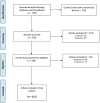An 'incredible community' or 'disgusting' and 'weird'? Representations of breastmilk sharing in worldwide news media
- PMID: 33404174
- PMCID: PMC8189212
- DOI: 10.1111/mcn.13139
An 'incredible community' or 'disgusting' and 'weird'? Representations of breastmilk sharing in worldwide news media
Abstract
Breastmilk sharing via the internet has become more popular in recent years, with a resultant increase in media attention. It is actively discouraged by public health bodies in at least three countries. We undertook a qualitative analysis of worldwide English language news media (online newspaper articles and transcripts of television and radio pieces) focusing on peer-to-peer breastmilk sharing during a 24-month period (2015-2016). One hundred eleven news articles were analysed semiotically for positive (n = 49) and negative (n = 90) depictions of breastmilk sharing and the actors involved. Three countries published the majority of the articles: United States (n = 42), United Kingdom (n = 24) and Australia (n = 20). Topics associated with using shared breastmilk included perceived insufficiency, having surgery or taking medication, or the prematurity of the baby. Reports of women who gave and received breastmilk were largely positive although sometimes confused with women who sell breastmilk, who were demonised. The breastmilk itself, however, was considered as potentially contaminated and possibly dangerous; calls for action (n = 33) focused on increasing regulation and safety. Peer-to-peer milk sharing and the commercial availability of human milk are activities that occur within social and cultural contexts, and, as such, the ways in which they are represented in the news media reflect the ways in which they are also represented more widely in society. Increased understanding of normal infant feeding practices is needed, alongside guidance on how to better support breastfeeding. News media outlets can facilitate this through reporting risk in line with evidence. Further research should be undertaken to understand the safety of breastmilk sharing and the experience of those who participate.
Keywords: breast milk; breastfeeding; human milk; mass media; qualitative research; stigma.
© 2021 The Authors. Maternal & Child Nutrition published by John Wiley & Sons Ltd.
Conflict of interest statement
Sally Dowling has previously received funding from the Economic and Social Research Council and from South Gloucestershire and Wiltshire Local Authorities. She is a co‐recipient of two internal research awards from UWE, Bristol (Vice Chancellor's Challenge Fund). Aimee Grant has received funding from the National Institute for Health Research, Economic and Social Research Council, the Wellcome Trust ISSF and the Welsh Crucible Small Grant Scheme. She has also undertaken paid consultancy for Public Health Wales NHS Trust, where she previously held the role of Senior Health Promotion Practitioner. She is affiliated with the Action on Smoking and Health (ASH) Wales Cymru research committee, where she previously held the role of Research and Policy Officer.
Figures
Similar articles
-
Milk sharing in practice: a descriptive analysis of peer breastmilk sharing.Breastfeed Med. 2015 Jun;10(5):263-9. doi: 10.1089/bfm.2015.0009. Epub 2015 May 14. Breastfeed Med. 2015. PMID: 25973632
-
Contested moral landscapes: Negotiating breastfeeding stigma in breastmilk sharing, nighttime breastfeeding, and long-term breastfeeding in the U.S. and the U.K.Soc Sci Med. 2016 Nov;168:178-185. doi: 10.1016/j.socscimed.2016.09.014. Epub 2016 Sep 10. Soc Sci Med. 2016. PMID: 27664771 Free PMC article.
-
Mothers' experiences of sharig breastfeeding or breastmilk co-feeding in Australia 1978-2008.Breastfeed Rev. 2009 Mar;17(1):9-18. Breastfeed Rev. 2009. PMID: 19385347
-
Expressed breastmilk handling and storage guidelines available to mothers in the community: A scoping review.Women Birth. 2020 Sep;33(5):426-432. doi: 10.1016/j.wombi.2019.09.009. Epub 2019 Oct 20. Women Birth. 2020. PMID: 31645302
-
Negative stereotypes, fear and social distance: a systematic review of depictions of dementia in popular culture in the context of stigma.BMC Geriatr. 2020 Nov 17;20(1):477. doi: 10.1186/s12877-020-01754-x. BMC Geriatr. 2020. PMID: 33203379 Free PMC article.
Cited by
-
Views on wet nursing and expressing breastmilk for sharing and human milk bank donation among mothers in two parenting social media communities in Vietnam.Matern Child Nutr. 2025 Jan;21(1):e13694. doi: 10.1111/mcn.13694. Epub 2024 Aug 15. Matern Child Nutr. 2025. PMID: 39145992 Free PMC article.
References
-
- Boyer, K. (2010). Of care and commodities: Breastmilk and the new politics of mobile biosubstances. Progress in Human Geography, 34(5), 5–20. 10.1177/0309132509105003 - DOI
-
- Boyer, K. (2014). ‘Neoliberal motherhood’: Workplace lactation and changing conceptions of working motherhoodin the contemporary US. Feminist Theory, 15, 269–288. 10.1177/1464700114545321 - DOI
-
- Bresnahan, M. , Zhu, Y. , Zhuang, J. , & Yan, X. (2019). “He wants a refund because I'm breastfeeding my baby”: A thematic analysis of maternal stigma for breastfeeding in public. Women & Health, 58, 394–403. 10.1037/sah0000208 - DOI
-
- Carter, S. K. , & Reyes‐Foster, B. M. (2015). Liquid gold or Russian Roulette? Risk and human milk sharing in the U.S. news media. Health, Risk & Society, 17, 30–45. 10.1080/13698575.2014.1000269 - DOI
MeSH terms
LinkOut - more resources
Full Text Sources
Other Literature Sources
Medical
Miscellaneous



